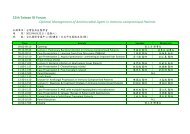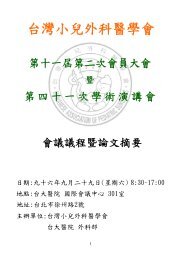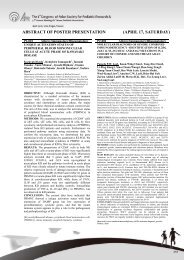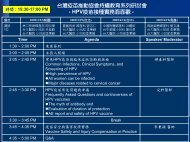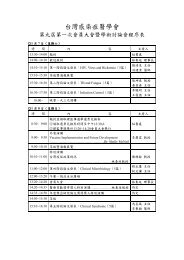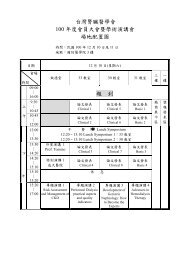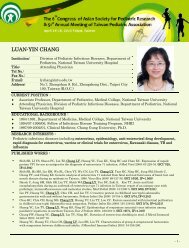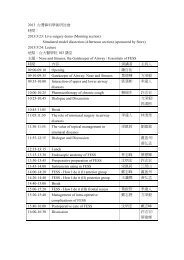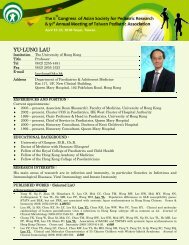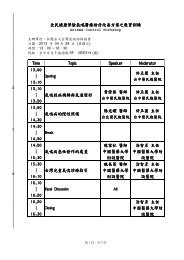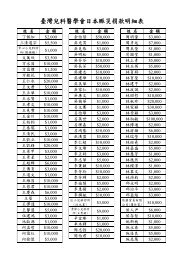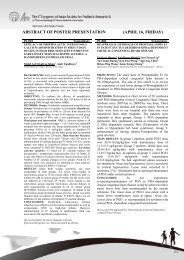ABSTRACT OF INVITED LECTURES AND ORAL PRESENTATION
ABSTRACT OF INVITED LECTURES AND ORAL PRESENTATION
ABSTRACT OF INVITED LECTURES AND ORAL PRESENTATION
- No tags were found...
You also want an ePaper? Increase the reach of your titles
YUMPU automatically turns print PDFs into web optimized ePapers that Google loves.
FP10-04CHARACTERIZATION <strong>OF</strong>NEUROBLASTOMA USING F-18-DOPAPET/CTMeng Yao Lu 1 , Kai-Yuan Tzen 2 , Shiann-Tarng Jou 1 ,Hsiu-Hao Chang 1 , Yung-Li Yang 1 , Kai-Hsin Lin 1 ,Dong-Tsamsn Lin 1 , Wen-Ming Hsu 31 Dept of Pediatrics, 2 Dept of Nuclear Medicine, 3 Dept of Surgery, NationalTaiwan University Hospital, Taipei, TaiwanOBJECTIVES: Tumors of ganglion cell origin includingganglioneuroma, neuroblastoma and ganglioneuroblastomaare common tumors in children. Iodinated MIBG and FDGPET-CT are the choice for functional imaging studies. Inthe recent year, F-18 DOPA has emerged as a newdiagnostic tool for neuroendocrine tumors. We try to applyand characterize the functional status of the neuroblastomain limited number of cases of our institution.METHODS: After 100 mg of carbidopa was given orallyfor 60 mins, the patients was injected with 200 MBq (5.4mCi) of F-18-DOPA and wait for 90 mins for imaging.Whole body imaging was performed using PET/CT. Thepatients also received the standard I123-MIBG, FDGPET-CT imaging studies.RESULTS: Nineteen patients with neuroblastoma wereenrolled in this study. Their ages ranged from 0.5-12.8years old. All patients had F-18-DOPA PET scan. Threepatients were primary diagnosis/staging of disease and 16cases were restaging of disease. Three primary diagnosispatients showed positive uptake of F-18-DOPA in primaryand metastasis lesions. In restaging patients, five patientswithout uptake of F-18-DOPA showed negative standardimaging studies. Eleven patients with uptake ofF-18-DOPA showed only 6 positive I123-MIBG and 7positive FDG PET/CT. In organ-region-specific analysis,there were different uptake pattern in 3 imaging studies.CONCLUSIONS: No study on the possible role ofF-18-DOPA in neuroblastoma has been published yet. Inour study, we found a major drawback of FDG PET/CTwas lack of visualization of lesions in the liver andcranium because of high physiologic activity. Anotherdisadvantage of FDG PET/CT was not disease-specific.F-18-DOPA is a better substrate for the cell membranenorepinephrine transporter than MIBG and a more specificsubstrate for neuroblastoma cells than FDG. F-18-DOPAmight provide more additional information than FDGPET/CT in this area. F-18-DOPA positivity indicates theability of tumor cells to accumulate and the ability todecarboxylate F-18-DOPA by AADC in a welldifferentiated tumor or tumor component. This mightindicate better prognosis. The clinical significance needsfurther follow up.[Keywords]Neuroblastoma, F-18-DOPA PET/CTFP10-05IRINOTECAN AS A C<strong>AND</strong>IDATE IN THESALVAGE REGIMEN FOR ACUTELYMPHOBLASTIC LEUKEMIAHiroaki Goto 1 , leo Tanoshima 2 , Hiromi Kato 3 , TomokoYokosuka 4 , Masakatsu Yanagimachi 5 , Ryosuke Kajiwara 6 ,Shumpei Yokota 7Department of Pediatrics, Yokohama City University Hospital 1 , Pediatrics,Yokohama City University 2,3,4,5,6 , Deaprtment of Pediatrics, Yokohama CityUnivrersity School of Medicine 7 ( Japan)BACKGROUND: B cell-precursor acute lymphoblastic leukemia(BCP-ALL) is the most frequent malignant disease in children.Childhood BCP-ALL can be cured by chemotherapy. Howeverthere remain relapse or refractory diseases, and the salvageregimens for those are limited. The camptothecin analog,topotecan, has been shown to be effective against relapse ALL.Our recent study using the cell lines suggested the activity ofirinotecan, the other camptothecin analog, in BCP-ALL.AIM: To investigate the role of irinotecan in a salvage therapy forBCP-ALL.MATERIALS <strong>AND</strong> METHODS: Two BCP-ALL cell lines,YCUB-2 and YCUB-4, and 12 clinical leukemic samples obtainedfrom childhood BCP-ALL patients were used. The cytotoxicity ofSN38, an active metabolite of irinotecan, or other drugs wasevaluated by the MTT assay or the flow cytometricchemosensitivity assay (FCCA). (1) To evaluate the time or dosedependence of SN38 cytotoxicity, YCUB-2 cells were exposed toSN38 at 1 to 10 ng/ml for 1 to 18 hours, then washed and grown inthe medium without SN38. At 48 hours after the start of culture, %survival compared to untreated control was measured by theFCCA. (2) To evaluate the effects of SN38 in combination withother drugs, YCUB-2 or YCUB-4 cells were cultured for 4 dayswith SN38 combined with2-fluoroadenine-9-β-D-arabinofuranoside (F-ara-A), etoposide(ETOP), cytosine β-D-arabinofuranoside (AraC), or4-hyroperoxy-cyclophosphamide (CPM) at differentconcentrations. The combination effects of two drugs wereassessed by an improved isobologram method. (3) The cytotoxicityof SN38 was compared to that of topotecan in the BCP-ALLclinical samples by the FCCA after 2 days culture.RESULTS: (1) SN38 inhibited the growth of YCUB-2 cells in thetime- and dose-dependent manner, although it failed to showcytotoxicity at the low (1ng/ml) concentration even after longexposure. The effect of SN38 correlated significantly with relativeAUC (P < 0.001). (2) SN38 was found to have a synergistic oradditive effect with CPM. In contrast, SN38 acted only additivelywith F-ara-A, ETOP, or AraC. (3) Among the BCP-ALL clinicalsamples, the sensitivity to SN38 correlated significantly with thatto topotecan (P = 0.008).CONCLUSIONS: We could not show the advantage of usingirinotecan over topotecan in the series of the BCP-ALL clinicalsamples, however, there were some cases which respondedpreferentially to SN38. Our results suggest that it may bebeneficial to develop the combination chemotherapy of irinotecanand cyclophosphamide as a salvage regimen for BCP-ALL.[Keywords] acute lymphoblastic leukemia, B cell precursor, irinotecan, SN38,cell line92



